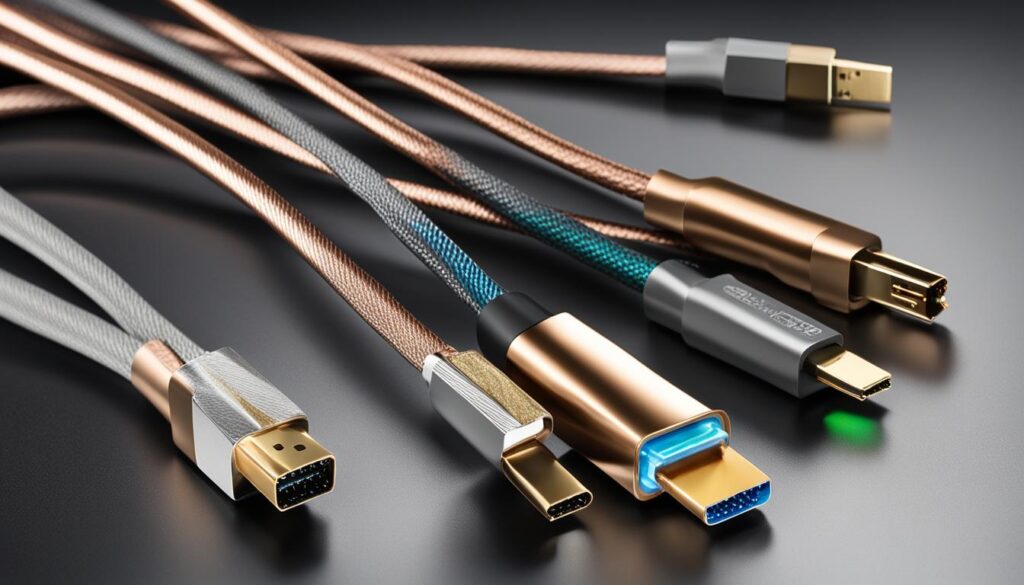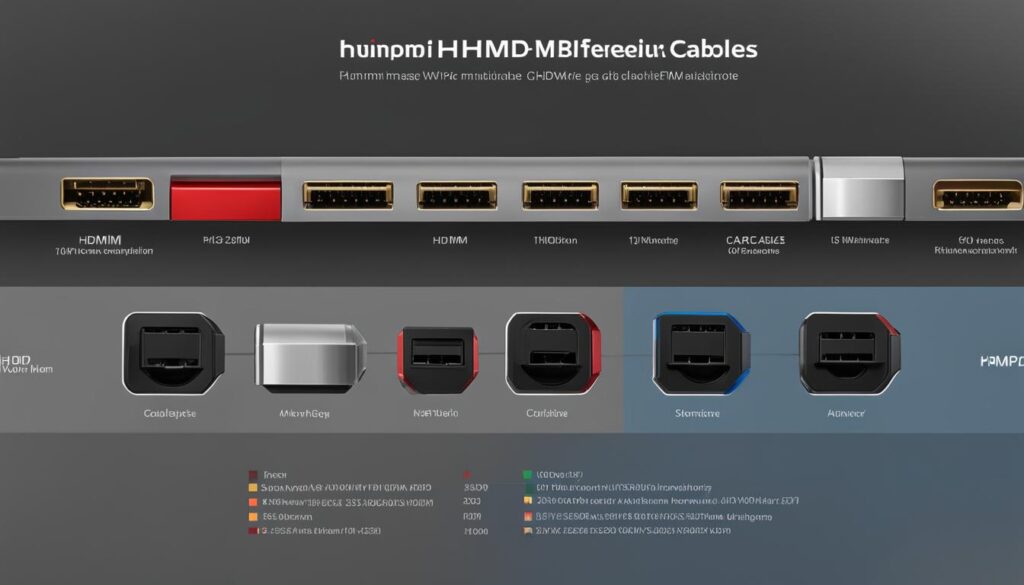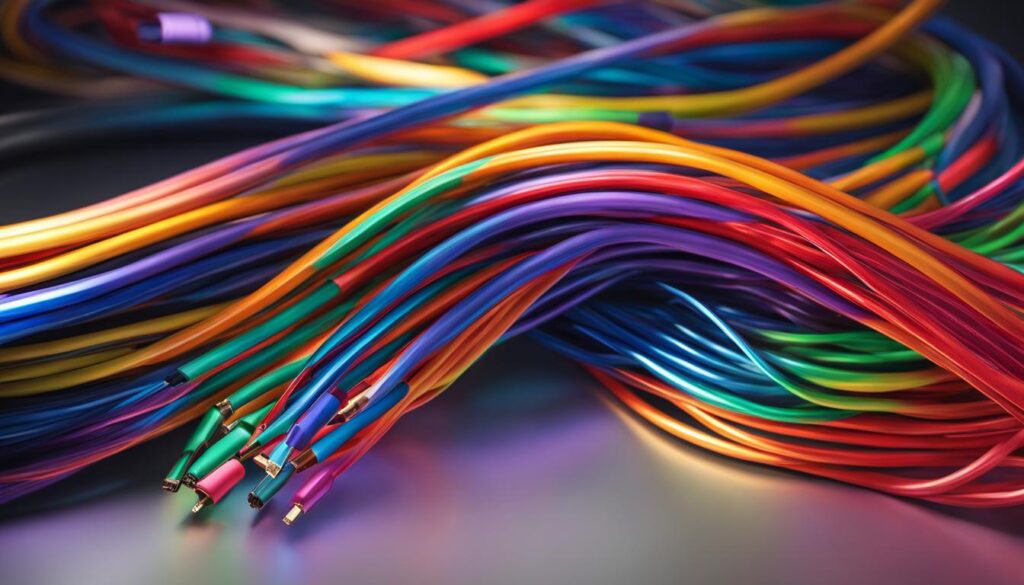You’re probably familiar with HDMI cables, those ubiquitous connectors that seamlessly transmit audio and video signals from your favorite devices to your TV or monitor. But have you ever pondered what’s going on under that sleek black casing? The true power of an HDMI cable lies within its complex construction—precision-engineered to deliver crystal-clear digital content straight to your screen.
What makes HDMI cables exceptional is their HDMI wire count, which isn’t just about the numbers; it’s about the harmony of cable internals working together for peak performance. From the types of HDMI cables to the specific HDMI wire gauge essential for high-definition quality, every aspect of the HDMI connector anatomy is designed with purpose.
Whether you’re a home theater enthusiast or a professional seeking the finest in cable construction, understanding the intricate world of HDMI cables enhances not only your knowledge but also your audiovisual experience. So let’s dive deeper into the engineering marvel that is the HDMI cable.
Key Takeaways
- The complex internals of HDMI cables include a specific HDMI wire count that supports the transmission of high-fidelity audio and video.
- Types of HDMI cables vary, with each designed to accommodate different HDMI standards and capabilities.
- HDMI wire gauge and connector anatomy are critical factors that affect the cable’s ability to handle bandwidth-intensive content.
- Cable construction with proper shielding is essential to protect against interference and maintain signal integrity.
- An understanding of the makeup of HDMI cables can help you choose the right one for your setup, based on the required resolution and refresh rate.
Introduction to HDMI Cable Technology
With the rise of high-definition visuals and pristine sound quality, HDMI technology has become the cornerstone for digital audio and video experiences that dazzle the senses. It’s the invisible thread that weaves through your cutting-edge gaming consoles, streaming devices, and home theater systems, carrying with it the promise of an immersive entertainment oasis. HDMI cable uses are diverse, connecting sources like Blu-ray players and satellite boxes to display endpoints such as TVs and monitors with unmatched fidelity.
As resolutions soar and soundscapes deepen, the evolution of HDMI standards and HDMI specs continues to accelerate. Every iteration ushers in new advancements, enabling HDMI cables to not just keep pace but set the stage for the audio-visual banquet that modern devices serve up. Each HDMI connector type is meticulously crafted to ensure a snug, secure fit, paving the way for an uninterrupted stream of digital delight.
- Do you prefer an angular approach with fixed installations? The standard Type A connector might be your go-to.
- Keen on a sleeker, more compact solution for portable devices? The Micro HDMI (Type D) stands ready to fit into tighter spaces without sacrificing performance.
Whether you’re streaming the latest high-octane action flick or indulging in a symphonic audio masterpiece, HDMI signal quality remains paramount. It’s the lifeblood of your setup, a hidden hero ensuring that every pixel and sound wave is transmitted in pristine condition. But that’s not all—cable performance is just as vital, playing a subtle yet significant role in buffering against potential pitfalls such as interference or signal degradation.
Let’s delve into a comparative glance at various HDMI standards to appreciate the strides achieved over the years:
| HDMI Standard | Resolution | Audio Features | Data Transfer Rates |
|---|---|---|---|
| HDMI 1.4 | 4K @ 30Hz | Audio return channel | Up to 10.2 Gbps |
| HDMI 2.0 | 4K @ 60Hz | Support for up to 32 audio channels | Up to 18 Gbps |
| HDMI 2.1 | 8K @ 120Hz and 4K @ 120Hz | Enhanced audio return channel (eARC) | Up to 48 Gbps |
As you gear up to select the perfect HDMI cable for your home theater or gaming setup, consider how these evolving standards reflect your current and future multimedia needs. From the comfort of your couch or your immersive gaming chair, the right HDMI technology can elevate your digital escapades to celestial heights. So go ahead—indulge in the highest echelons of audio and visual splendor with HDMI as your trusted guide.
The Anatomy of an HDMI Cable
Peeking into the casing of your HDMI cable, you’d find a sophisticated world designed for peak digital signal transmission. This section pulls back the curtain to reveal the HDMI connector anatomy, a realm where HDMI pin structure and HDMI copper conductors coalesce to create an orchestra of electrons that creates the audiovisual symphony you enjoy.
Let’s break down the components that make up an HDMI cable, from the male HDMI connectors and female HDMI ports to the precise HDMI terminal configuration, and understand how each part plays a crucial role in ensuring high-definition content flows seamlessly from your device to your screen.
Understanding the HDMI Connector and Pin Configuration
At the heart of any HDMI cable is the connector, a complex piece that houses multiple pins. Each pin has its specialized function. For instance, some are dedicated to video signals, some to audio, and others to control signals. The standard configuration consists of 19 pins in both male HDMI connectors and female HDMI ports, maintaining consistency and reliability across different devices.
Exploring the Role of Copper Conductors in HDMI Cables
Inside HDMI cables, HDMI copper conductors are working tirelessly. Twisted into pairs, these conductors are the pathways through which your data travels. The wire gauge, a measure of the wire’s thickness, can vary – thicker wires (lower gauge numbers) can carry more data over longer distances with higher signal fidelity.
Here’s a quick guide when it comes to conductor materials:
- Copper: The go-to conductor material for HDMI cables, balances conductivity with cost-efficiency.
- Silver-Plated Copper: For those seeking enhanced performance without the cost of solid silver, this is a common choice in higher-end cables.
The Importance of Shielding and Insulation in HDMI Performance
Your HDMI cable’s performance hinges not just on the internal conductors, but also on how well it shields against electromagnetic interference (EMI) and radio-frequency interference (RFI). Shielding, typically via both foil and braided techniques, serves as the armor that protects signal integrity from outside disturbances. Shielded HDMI cables coupled with high-quality cable insulation ensure that whether you’re gaming or binge-watching, the experience remains unspoiled by external interference.
Let’s look at some common shielding techniques:
- Foil Shielding: Provides a solid barrier against EMI/RFI over the entire surface area of the cable.
- Braid Shielding: Offers additional strength and protection, minimizing the potential for damage that could compromise cable performance.

Your HDMI cable is more than just a wire; it’s an elegantly designed conduit for your entertainment and productivity. So next time you plug in, you’ll know there’s a world of precision behind every pixel and pitch that hits your senses.
Dissecting the HDMI: A Look Inside the Cable
When you delve into the intricacies of an HDMI cable, you’re met with a sophisticated arrangement of components that combine to form the lifeline of your audiovisual experience. It’s here, inside the HDMI cable, where the magic of seamless signal transmission resides, from electrifying gaming sessions to captivating cinematic journeys.
Taking a closer look at the HDMI wire arrangement and the electrical cable anatomy helps us appreciate the excellence of modern engineering. The internal wire configuration of HDMI cables is no simple affair; instead, it is a testament to years of technological advancement and precision design.
Understanding the roles of each segment in the HDMI shielding internals and the significance of the cable’s cross-section will enhance your knowledge of how quality visuals and audio are maintained. The following exploration into HDMI cable internals will illuminate the silent yet powerful operations behind every screen flicker and sound byte.
The Core Design of HDMI Wiring
- The standard HDMI cable consists of 19 individual wires wrapped in multiple layers of shielding.
- Each wire within the internal configuration serves a distinct purpose, such as transmitting video, audio, or control signals.
- Quality cables often feature a robust twist pattern that aids in minimizing crosstalk and other signal disruptions.
Crucial Elements: Shielding and Insulation
Key to the robustness of any HDMI cable is its shielding—an intricate layer that envelops the internal wiring, warding off electronic noise and interference that can corrupt your signal.
- Foil shielding is tasked with providing consistent coverage against electromagnetic influences over the entire HDMI cable.
- Braid shielding offers a secondary defensive layer, imparting both protection against physical damage and EMI/RFI interference.
A deep dive into the design reveals a tight ecosystem within the charger cable wherein each component—from the copper conductors to the intricate wiring—is meticulously optimized for delivering an unparalleled digital experience. This splendid symphony of parts within your HDMI cable bodes well for flawless audiovisuals, no matter your entertainment or professional demands.
Anatomy of the Cross-Section
The typical cross-section of an HDMI cable is a marvel to behold—an orderly set of wires and protective layers all honed for signal integrity:
| Layer | Composition | Function |
|---|---|---|
| Outer Jacket | Durable polyvinyl chloride (PVC) | Physical protection and flexibility |
| Shielding Layers | Combination of aluminum foil and braided tinned copper | Defends against EMI/RFI, maintains signal purity |
| Insulation | High-density polyethylene (HDPE) | Electrically separates wires, preventing shorts |
| Conductors | Oxygen-free copper or silver-plated copper | Transmit data signals with minimal resistance |
The cross-sectional architecture of HDMI cables not only supports efficient data transfer but also ensures longevity and consistent performance. By becoming familiar with these elements, you will be better equipped to select cables that can handle the rigorous demands of today’s high-definition content.
With this newfound recognition of the complexity inside HDMI cables, you can appreciate the engineering that ensures every moment of your digital life is as vibrant and clear as the technology promises. From intricate HDMI wire arrangements to the foresight in HDMI shielding internals, each element plays a part in securing the breathtaking clarity of image and sound we’ve come to expect.
Differentiating Between HDMI Cable Versions and Wire Composition

As you venture into the realm of high-definition multimedia, it’s crucial to understand that not all HDMI cables are created equal. Your audio-visual setup’s performance pivots on the precise interplay of HDMI versions, HDMI wire composition, and the HDMI cable types you choose. The evolution from HDMI 1.4 to HDMI 2.1 has been underwritten by significant changes in internal wire structure and composition, reflecting the rapid advances in technology and consumer demand for higher-quality content.
Impact of HDMI Versions on Internal Wire Structure
The internal makeup of an HDMI cable can be as varied as the versions themselves. Each advancement in HDMI technology – from 1.4 and 2.0 to the robust 2.1 – ushers in not just improvements in performance categories but also version-specific wire arrangements that are engineered to carry more data faster and more efficiently.
A striking illustration of this variation is the difference in wire count and shielding requirements necessitated by evolving HDMI standards. Let’s break down how these versions differ and what that means for your home theater or gaming experience.
- HDMI 1.4 cables are often the entry point for HD content. They feature a simpler internal structure apt for 1080p resolution and 3D video support. The wire composition of these cables sufficiently handles the data rates up to 10.2 Gbps that this version requires.
- Moving up to HDMI 2.0, the wire complexity increases to accommodate enhanced video resolutions, including 4K at 60Hz. These cables have higher wire count variations and sometimes thicker gauge wiring, thus enabling them to support bandwidth up to 18 Gbps.
- The pinnacle of current HDMI technology is the HDMI 2.1, designed to handle the ultra-high-speed data transfer required for 8K resolution and beyond. With a colossal bandwidth capacity of up to 48 Gbps, these cables often include additional shielding layers and specialized wire arrangements to keep signal integrity intact over greater frequencies and longer distances.
The table below showcases how the internal structure varies according to the HDMI version:
| HDMI Version | Typical Wire Count | Maximum Bandwidth | Required Shielding |
|---|---|---|---|
| HDMI 1.4 | 14-19 | 10.2 Gbps | Standard Shielding |
| HDMI 2.0 | 19 | 18 Gbps | Enhanced Shielding |
| HDMI 2.1 | 19+ | 48 Gbps | Advanced Shielding |
In your pursuit of unmatched audiovisual quality, understanding HDMI cable versions becomes indispensable. Empower your entertainment system by choosing the right HDMI cable that aligns with your device capabilities and desired performance. Remember, the intricate dance of electrons through the wires of an HDMI cable brings the gallery of pixels and cascade of sounds to life, transforming the way you experience digital content.
HDMI Wire Count: The Elements of Signal Transmission
When it comes to connecting your multimedia devices, the HDMI wire count within the cables you use is pivotal to achieving the ultimate audiovisual quality. Understanding the conductor count in HDMI cables and their relationship with signal transmission will guide you in selecting the ideal cable that ensures a stunning high-definition experience.
The strength of an HDMI cable lies in its ability to transfer data at high speeds, a capability that hinges on the HDMI bandwidth capability of the wire. Let’s dive into the details of how the wire count affects the efficiency of your HDMI cable.
HDMI cables contain multiple conductors that handle simultaneous high-speed data rate transfer, necessary for rendering crisp video and rich audio. But how many wires are we talking about? Typically, the inner workings of these technological lifelines boast 19 copper conductors, each dedicated to specific parts of the signal transmission process.

This intricate configuration supports the full spectrum of HDMI’s high-bandwidth streams. These streams include not only video and audio but also auxiliary information, like control and Ethernet data, in cables equipped with such features.
In layman’s terms, the conductor count in HDMI cables directly influences the breadth and quality of data that can be transmitted. As the resolutions of displays continue to soar, the demands on HDMI cables do the same. Insufficient wire counts can lead to compromised audiovisual quality due to bandwidth limitations.
| HDMI Version | Conductor Count | Signal Transmission Capability |
|---|---|---|
| HDMI 1.4 | 19 | Standard Definition, High Definition, and 4K@30Hz |
| HDMI 2.0 | 19 | 4K@60Hz and Higher Color Depth |
| HDMI 2.1 | 19+ | 8K@60Hz, 4K@120Hz, and More |
Note the “+” next to the wire count for HDMI 2.1 — this symbolizes an advanced setup capable of handling a whooping 48 Gbps, making it future-proof for even greater resolutions and frame rates on the horizon.
Every wire inside your HDMI cable adds to its capabilities. But it’s not only about the number; the quality of these conductors and the precision of their arrangement are equally vital in keeping the signal clear and the transmission steady, regardless of electromagnetic noise or long cable runs.
In your pursuit of high-fidelity home entertainment or a professional-grade multimedia presentation, the HDMI wire count and signal transmission go hand in hand. So choose wisely, ensuring that your cable not only matches but exceeds your HDMI bandwidth capability needs. This way, you’ll sustain the impeccable quality you deserve across all your devices.
Advanced Features and The Wire Count: Audio, Video, and Ethernet
Embracing the latest in HDMI advanced features means understanding the profound impact wire count and HDMI cable enhancements have on your digital AV experience. With each new design specification, HDMI technology strides forward into a future where vivid, lifelike audio and video have become the norm. Whether you are setting up your home theater or configuring a professional system, the wire count inside your HDMI cables is not merely a number—it’s a pivotal foundation for advanced functionalities like Ethernet over HDMI and integrated audio support.
How Enhanced Features Influence HDMI Design Specifications
The meticulous architecture of HDMI cables is influenced by the growing appetite for enriched audio and video support. As you watch your 4K content with breath-taking clarity and listen to immersive surround sound, remember it’s the advanced HDMI design specifications making it possible. The implications for data throughput bring us to the essence of HDMI’s progressive journey—each advancement requiring a wire count capable of handling the substantial increase in information transfer.
- **Ethernet Over HDMI**: This feature allows your HDMI cable to facilitate network connection sharing between your devices, reducing the clutter of extra cables. But its inclusion necessitates careful balancing in the wire count to accommodate data channels without any loss in quality.
- **Audio Return Channel (ARC)**: This handy feature sends the audio from your smart TV back to your sound system over the same HDMI cable that delivers the audiovisual feed to your TV. In essence, the presence of ARC mandates a cable design that ensures audio signals traverse the complex arrangement without interference.
As the demands for higher resolutions persist, the design specifications are ever-evolving to ensure HDMI cable enhancements meet the necessary bandwidth requirements. Next, let’s break down how Ethernet, audio, and video requirements directly impact the wire count and internal structure of HDMI cables.
| Feature | Wire Count Impact | Design Specifications |
|---|---|---|
| High-Definition Video | Increased number of conductors to accommodate more complex color spaces and higher resolutions. | More twisted pairs and specialized insulation to minimize crosstalk and signal degradation. |
| Multi-Channel Audio | More wires for distinct audio channels, supporting greater audio depth and clarity. | Cable enhancements to preserve audio signal quality over longer distances. |
| Ethernet over HDMI | Addition of dedicated data channel wires, integrated within the HDMI cable. | Additional layers of shielding to counter potential interference from Ethernet data streams. |

To ensure enhanced features like Ethernet over HDMI and ARC without impacting the principal audio and video support, HDMI cables are meticulously designed with a precise number of wires and robust shielding. This ensures that digital AV signals travel with optimal integrity, offering you a rich, uninterrupted entertainment experience.
When you are in the market for a new HDMI cable, consider these enhancements not as mere specs but as integral components that guarantee the fidelity of your multimedia setup. Remember, the appropriate wire count impact and design specifications are fundamental to achieving a seamless and enriched digital AV experience.
From Standard to High-Speed: The Evolution of HDMI Cables
As you immerse yourself in the ever-changing world of digital connectivity, the evolution of HDMI cables stands as a testament to technological progress. From their inception as standard HDMI, these versatile conduits have transformed to meet increasing bandwidth demands, paving the way for the high-speed HDMI cables we rely on today. This continual HDMI cable progress reflects not only the emerging HDMI trends but also the tech industry’s commitment to enhancing your audio-visual encounters.
HDMI cables have journeyed from humble beginnings, accommodating simple 720p or 1080i resolutions, to the ultra-high-definition realms we now enjoy. This progression was necessary to stay ahead of the increasing quality offered by devices such as gaming consoles, streaming services, and home theater systems. A breakthrough came with the introduction of standard HDMI cables, ushering in a new era of uncompressed digital transfer.
However, the relentless advancement did not stop there. The emergence of high-speed HDMI cables coincided with the growing desire for richer images, deeper colors, and more fluid motion. Let’s retrace the significant milestones that mark the HDMI cable’s ascent to indispensability in our connected lives.
- Standard HDMI transformed the way audio and video devices interact, but it was just the beginning.
- High-speed HDMI emerged to capitalize on 1080p resolution, enhancing visual fidelity and audio clarity.
- The quest for 4K resolution at 30 Hz led to further enhancements, increasing the cable’s data transfer capabilities.
- With the advent of HDMI 2.0, cables had to support double the refresh rate — a 60 Hz frequency for 4K content became the new norm.
- As 3D technology entered the mainstream and HDR (High Dynamic Range) became more popular, HDMI cables needed to evolve once again.
But what does this mean for you? With each new version, HDMI cables have become more complex internally. The higher the version, the more specific the requirements for data transmission, directly affecting their construction and capability.
Consider the table below as a quick reference to the evolution from standard to high-speed and beyond:
| HDMI Development Stage | Resolution Support | Refresh Rate | Bandwidth |
|---|---|---|---|
| Standard HDMI (HDMI 1.4) | Up to 1080p | 60 Hz | 10.2 Gbps |
| Extended HDMI (Early high-speed) | 1080p to 4K | 30 Hz (4K) | Varies |
| High-Speed HDMI (HDMI 2.0) | 4K | 60 Hz | 18 Gbps |
| Ultra High-Speed HDMI (HDMI 2.1) | 8K and 4K@120Hz | 120 Hz | 48 Gbps |
Moving beyond HDMI 2.0, the rapid transition to HDMI 2.1 exemplifies an industry constantly adapting to satisfy your yearning for a crisper, more engaging visual display. This latest iteration supports astonishing resolutions and frame rates that were once the realm of fantasy for tech aficionados.
In essence, the HDMI cable’s core design has had to mature rapidly, sprouting intricate pathways capable of accommodating the ever-thickening stream of data. Your selection of an HDMI cable should not only tally with your current equipment but also anticipate future trends and advancements in display technology. The ongoing evolution of HDMI cables ensures you’re always at the cutting edge of audio-visual excellence, with each cable carrying the potential for extraordinary immersive experiences.
Practical Insights: How the Internal Wire Arrangement Affects You
When selecting HDMI cables, the sea of options can be daunting, but your choice profoundly impacts the quality of your multimedia experience. Whether you’re on the hunt for the best HDMI cable for 4K or need a trusty link for standard definition, it’s crucial to consider the appropriate HDMI type and cable compatibility. A consumer HDMI buying guide can provide valuable assistance, ensuring you navigate through the maze of technological jargon towards the cable that best suits your needs. Remember, the internal wire arrangement of an HDMI cable dictates its capacity to carry high-definition signals without compromise.
Maintaining HDMI cable integrity is pivotal in preserving signal integrity and ensuring optimal performance. To avoid signal loss and prolong your cable’s durability, it’s essential to give thought to cable care and the practices surrounding it. Effective cable management involves steering clear of tight bends, which can stress the wires, and protecting your cables from physical damage that could degrade their performance. Regular inspections can go a long way in upholding HDMI cable life span, and in turn, maintaining the crisp, clear imagery and sound you cherish in your digital endeavors.
Your diligent attention to these details translates into an enriched entertainment or professional setup, free from unnecessary disruptions. With careful selection and attentive care, your HDMI cables will offer a sturdy bridge for your audiovisual content, enveloped in the assurance of quality and fidelity. Whether you’re connecting a gaming console, streaming device, or home theater system, understanding the essence of HDMI cable integrity is the key to a seamless, vivid, and dynamic experience that stands the test of time.
